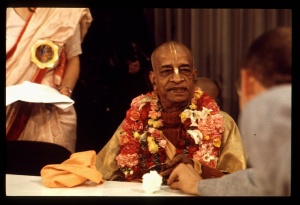SB 4.7.59: Difference between revisions
m (1 revision(s)) |
No edit summary |
||
| Line 1: | Line 1: | ||
{{info | {{info | ||
|speaker=Maitreya | |speaker=Maitreya Ṛṣi | ||
|listener=Vidura | |listener=Vidura | ||
}} | }} | ||
[[Category:Srimad-Bhagavatam - Canto 04 Chapter 07]] | |||
[[Category:Bhagavatam Verses Spoken by Maitreya Rsi - Vanisource|040759]] | |||
<div style="float:left">'''[[Srimad-Bhagavatam]] - [[SB 4|Fourth Canto]] - [[SB 4.7: The Sacrifice Performed by Daksa|Chapter 7: The Sacrifice Performed by Dakṣa]]'''</div> | |||
<div style="float:right">[[File:Go-previous.png|link=SB 4.7.58]] '''[[SB 4.7.58]] - [[SB 4.7.60]]''' [[File:Go-next.png|link=SB 4.7.60]]</div> | |||
{{RandomImage}} | |||
==== TEXT 59 ==== | ==== TEXT 59 ==== | ||
<div | <div class="verse"> | ||
tam eva dayitaṁ bhūya | :tam eva dayitaṁ bhūya | ||
āvṛṅkte patim ambikā | :āvṛṅkte patim ambikā | ||
ananya-bhāvaika-gatiṁ | :ananya-bhāvaika-gatiṁ | ||
śaktiḥ supteva pūruṣam | :śaktiḥ supteva pūruṣam | ||
</div> | </div> | ||
| Line 16: | Line 22: | ||
==== SYNONYMS ==== | ==== SYNONYMS ==== | ||
<div | <div class="synonyms"> | ||
''tam''—him (Lord Śiva); ''eva''—certainly; ''dayitam''—beloved; ''bhūyaḥ''—again; ''āvṛṅkte''—accepted; ''patim''—as her husband; ''ambikā''—Ambikā, or Satī; ''ananya-bhāvā''—without attachment for others; ''eka-gatim''—the one goal; ''śaktiḥ''—the feminine (marginal and external) energies; ''suptā''—lying dormant; ''iva''—as; ''pūruṣam''—the masculine (Lord Śiva, as representative of the Supreme Lord). | |||
</div> | </div> | ||
| Line 23: | Line 29: | ||
==== TRANSLATION ==== | ==== TRANSLATION ==== | ||
<div | <div class="translation"> | ||
Ambikā [goddess Durgā], who was known as Dākṣāyiṇī [Satī], again accepted Lord Śiva as her husband, just as different energies of the Supreme Personality of Godhead act during the course of a new creation. | Ambikā [goddess Durgā], who was known as Dākṣāyiṇī [Satī], again accepted Lord Śiva as her husband, just as different energies of the Supreme Personality of Godhead act during the course of a new creation. | ||
</div> | </div> | ||
| Line 30: | Line 36: | ||
==== PURPORT ==== | ==== PURPORT ==== | ||
<div | <div class="purport"> | ||
According to a verse of the Vedic mantras, parāsya śaktir vividhaiva śrūyate: [ | According to a verse of the Vedic ''mantras'', ''parāsya śaktir vividhaiva śrūyate'': ([[CC Madhya 13.65|CC Madhya 13.65, purport]]) the Supreme Personality of Godhead has different varieties of energies. ''Sakti'' is feminine, and the Lord is ''puruṣa'', masculine. It is the duty of the female to serve under the supreme ''puruṣa''. As stated in [[Bhagavad-gita As It Is (1972)|''Bhagavad-gītā'']], all living entities are marginal energies of the Supreme Lord. Therefore it is the duty of all living entities to serve this Supreme Person. Durgā is the representation in the material world of both the marginal and external energies, and Lord Śiva is the representation of the Supreme Person. The connection of Lord Śiva and Ambikā, or Durgā, is eternal. Satī could not accept any husband but Lord Śiva. How Lord Śiva remarried Durgā as Himavatī, the daughter of the Himalayas, and how Kārttikeya was born, is a great story in itself. | ||
</div> | </div> | ||
__NOTOC__ | |||
<div style="float:right; clear:both;">[[File:Go-previous.png|link=SB 4.7.58]] '''[[SB 4.7.58]] - [[SB 4.7.60]]''' [[File:Go-next.png|link=SB 4.7.60]]</div> | |||
__NOTOC__ | |||
__NOEDITSECTION__ | |||
Revision as of 13:16, 9 May 2021

A.C. Bhaktivedanta Swami Prabhupada
TEXT 59
- tam eva dayitaṁ bhūya
- āvṛṅkte patim ambikā
- ananya-bhāvaika-gatiṁ
- śaktiḥ supteva pūruṣam
SYNONYMS
tam—him (Lord Śiva); eva—certainly; dayitam—beloved; bhūyaḥ—again; āvṛṅkte—accepted; patim—as her husband; ambikā—Ambikā, or Satī; ananya-bhāvā—without attachment for others; eka-gatim—the one goal; śaktiḥ—the feminine (marginal and external) energies; suptā—lying dormant; iva—as; pūruṣam—the masculine (Lord Śiva, as representative of the Supreme Lord).
TRANSLATION
Ambikā [goddess Durgā], who was known as Dākṣāyiṇī [Satī], again accepted Lord Śiva as her husband, just as different energies of the Supreme Personality of Godhead act during the course of a new creation.
PURPORT
According to a verse of the Vedic mantras, parāsya śaktir vividhaiva śrūyate: (CC Madhya 13.65, purport) the Supreme Personality of Godhead has different varieties of energies. Sakti is feminine, and the Lord is puruṣa, masculine. It is the duty of the female to serve under the supreme puruṣa. As stated in Bhagavad-gītā, all living entities are marginal energies of the Supreme Lord. Therefore it is the duty of all living entities to serve this Supreme Person. Durgā is the representation in the material world of both the marginal and external energies, and Lord Śiva is the representation of the Supreme Person. The connection of Lord Śiva and Ambikā, or Durgā, is eternal. Satī could not accept any husband but Lord Śiva. How Lord Śiva remarried Durgā as Himavatī, the daughter of the Himalayas, and how Kārttikeya was born, is a great story in itself.